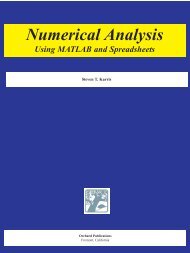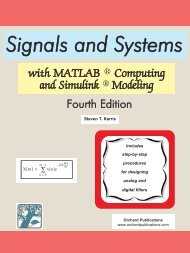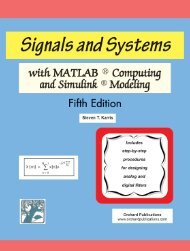COMPUTING
Second Edition - Orchard Publications
Second Edition - Orchard Publications
- No tags were found...
Create successful ePaper yourself
Turn your PDF publications into a flip-book with our unique Google optimized e-Paper software.
The Silicon Controlled Rectifier (SCR)AnodeAnodeAnodeAnodePPGateNPNGateNPNPNGateCathodeGateCathodeCathodeCathodeFigure 4.24. Parts of an SCR, the two−transistor equivalent circuit, and its symbolSCRs are mainly used where high currents and voltages are involved, and are often used to controlalternating currents, where the change of sign of the current causes the device to automaticallyswitch off. Like a diode, an SCR conducts only in one direction. A similar 5−layer device, called atriac, to be discussed on the next section, conducts current in both directions.Modern SCRs can switch large amounts of power (up to megawatts). In the realm of very highpower applications, they are still the primary choice. However, in low and medium power (fromfew tens of watts to few tens of kilowatts) they have almost been replaced by other devices withsuperior switching characteristics like MOSFETs. While an SCR is that is it not a fully controllableswitch in the sense that triggering current direction need to be reversed to switch it off, anewer device, the gate turn−off SCR (GTO) can be turned on and off with a signal applied to thegate. The turn−on signal is a small positive voltage and the turn−off is a negative small signal.GTOs are used for the output stages of medium−voltage, high horsepower, variable frequencydrives. In high−frequency applications, SCRs are poor candidates due to large switching times arisingout of bipolar conduction. MOSFETs, on the other hand, has much faster switching capabilitybecause of its unipolar conduction (only majority carriers carry the current). Figure 4.25 shows thevolt−ampere characteristics of a typical SCR.+IiPIV+VvFigure 4.25. The voltage−current characteristics of a typical SCRElectronic Devices and Amplifier Circuits with MATLAB Computing, Second EditionCopyright © Orchard Publications4−25







